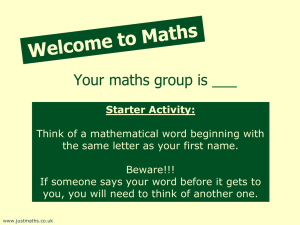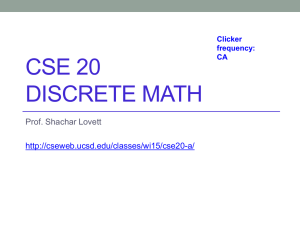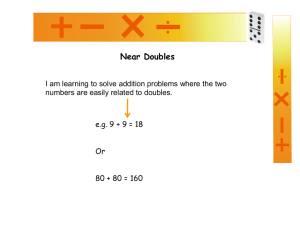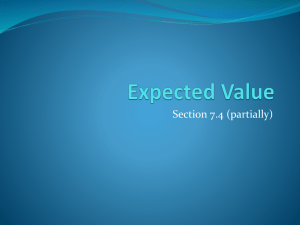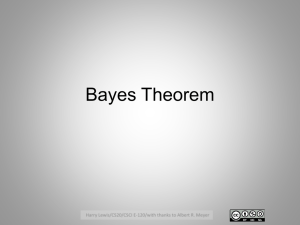Lecture17-More-Induction
advertisement
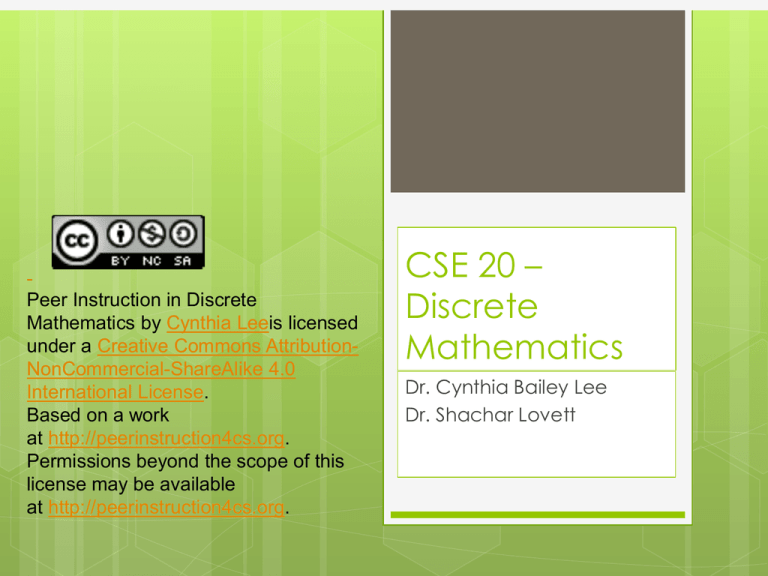
Peer Instruction in Discrete Mathematics by Cynthia Leeis licensed under a Creative Commons AttributionNonCommercial-ShareAlike 4.0 International License. Based on a work at http://peerinstruction4cs.org. Permissions beyond the scope of this license may be available at http://peerinstruction4cs.org. CSE 20 – Discrete Mathematics Dr. Cynthia Bailey Lee Dr. Shachar Lovett 2 Today’s Topics: 1. Mathematical Induction Proof 3-cents and 5-cents example Our first algorithm! 3 1. Mathematical Induction Proof Examples, examples, examples 4 3-cent and 5-cent coins We will prove the following theorem Theorem: For all prices p >= 8 cents, the price p can be paid using only 5-cent and 3-cent coins 1851-1889 1866-today 5 Thm: For all prices p >= 8 cents, the price p can be paid using only 5-cent and 3-cent coins. Proof (by mathematical induction): Basis step: Show the theorem holds for price p=____. Inductive step: Assume [or “Suppose”] that WTS that So the inductive step holds, completing the proof. 6 Thm: For all prices p >= 8 cents, the price p can be paid using only 5-cent and 3-cent coins. Proof (by mathematical induction): Basis step: Show the theorem holds for price p=________. Inductive step: Assume [or “Suppose”] that WTS that A. B. C. D. E. So the inductive step holds, completing the proof. 0 cents 1 cent 2 cents 3 cents Other/none/more than one 7 Thm: For all prices p >= 8 cents, the price p can be paid using only 5-cent and 3-cent coins. Proof (by mathematical induction): Basis step: Show the theorem holds for price p=8. Inductive step: Assume [or “Suppose”] that WTS that So the inductive step holds, completing the proof. 8 Thm: For all prices p >= 8 cents, the price p can be paid using only 5-cent and 3-cent coins. Proof (by mathematical induction): Basis step: Show the theorem holds for price p=8. Inductive step: Assume [or “Suppose”] that WTS that A. B. C. D. E. Theorem is true for p=8. Theorem is true for some p>8. Theorem is true for some p8. Theorem is true for some p>0. Theorem is true for all p>8. So the inductive step holds, completing the proof. 9 Thm: For all prices p >= 8 cents, the price p can be paid using only 5-cent and 3-cent coins. Proof (by mathematical induction): Basis step: Show the theorem holds for price p=8. Inductive step: Assume [or “Suppose”] that theorem is true for some p8. WTS that So the inductive step holds, completing the proof. 10 Thm: For all prices p >= 8 cents, the price p can be paid using only 5-cent and 3-cent coins. Proof (by mathematical induction): Basis step: Show the theorem holds for price p=8. Inductive step: Assume [or “Suppose”] that theorem is true for some p8. WTS that A. B. C. D. Theorem is true for p=8. Theorem is true for some p>8. Theorem is true for p+1. Theorem is true for p+8. So the inductive step holds, completing the proof. 11 Thm: For all prices p >= 8 cents, the price p can be paid using only 5-cent and 3-cent coins. Proof (by mathematical induction): Basis step: Show the theorem holds for price p=8. Inductive step: Assume [or “Suppose”] that theorem is true for some p8. WTS that theorem is true for price p+1. So the inductive step holds, completing the proof. 12 Thm: For all prices p >= 8 cents, the price p can be paid using only 5-cent and 3-cent coins. Proof (by mathematical induction): Basis step: Show the theorem holds for price p=8. Inductive step: Assume [or “Suppose”] that theorem is true for some p8. WTS that theorem is true for price p+1. ??? So the inductive step holds, completing the proof. 13 3-cent and 5-cent coins Inductive step: Assume price p8 can be paid using only 3cent and 5-cent coins. Need to prove that price p+1 can be paid using only 3-cent and 5-cent coints. Main idea: “reduce” from price p+1 to price p. 14 Making change If we have 100 5-cent coins, and 100 3cent coins (for a total of p = $8.00), how can we modify the number of 5-cent and 3-cent coins so that we can make the p+1 price (p+1 = $8.01)? A. B. C. 40 5-cent coins + 200 3-cent coins 39 5-cent coins + 202 3-cent coins 99 5-cent coins + 102 3-cent coins 15 Turning our modification scheme into a generic algorithm If we have n 5-cent coins, and m 3-cent coins (for a total of p = 5n+3m), how can we modify the number of 5-cent and 3cent coins so that we can make the p+1 price (p+1 = 5n+3m+1)? A. B. C. D. n+1 5-cent coins + m-2 3-cent coins n-1 5-cent coins + m+2 3-cent coins n+1 5-cent coins + m+2 3-cent coins No generic way 16 What if we don’t have any 5cent coins to subtract?? If we have 0 5-cent coins, and m 3-cent coins (for a total of p = 3m), how can we modify the number of 5-cent and 3-cent coins so that we can make the p+1 price (p+1 = 3m+1)? A. B. You can’t You can [explain to your group how] 17 What if we don’t have any 5cent coins to subtract?? If we have 0 5-cent coins, and m 3-cent coins (for a total of p = 3m), how can we modify the number of 5-cent and 3-cent coins so that we can make the p+1 price (p+1 = 3m+1)? Remove three 3-cent coins, add two 5-cent So: two 5-cent coins, m-3 3-cent points, for a total of 2*5+3*(m-3)=3m+1=p+1 18 That algorithm relies on being able to subtract three 3-cent coins. What if we don’t have that many? (only 1 or 2?) A. B. C. Uh-oh, our proof can not work as we’ve done it so far That could never happen [explain why not] That could happen, and we need to make a 3rd (or more) case(s) to handle it 19 Thm: For all prices p >= 8 cents, the price p can be paid using only 5-cent and 3-cent coins. Proof (by mathematical induction): Basis step: Show the theorem holds for p=8 (by example, e.g. p=3+5) Inductive step: Assume [or “Suppose”] that the theorem holds for some p8. WTS that the theorem holds for p+1. p8. Assume that p=5n+3m where n,m0 are integers. We need to show that p+1=5a+3b for integers a,b0. Partition to cases: Case I: n1. In this case, p+1=5*(n-1)+3*(m+2). Case II: m3. In this case, p+1=5*(n+2)+3*(m-3). Case III: n=0 and m2. Then p=5n+3m6 which is a contradiction to p8. So the inductive step holds, completing the proof. 20 We created an algorithm! Our proof actually allows us to algorithmically find a way to pay p using 3-cent and 5-cent coins Algorithm for price p: start with 8=3+5 For x=8...p, in each step adjust the number of coins according to the modification rules we’ve constructed to maintain price x 21 Algorithm pseudo-code PayWithThreeCentsAndFiveCents: Input: price p8. Output: integers n,m0 so that p=5n+3m 1. 2. Let x=8, n=1, m=1 (so that x=5n+3m). While x<p: a) b) c) 3. x:=x+1 If n1, set n:=n-1, m:=m+2 Otherwise, set n:=n+2, m:=m-3 Return (n,m) 22 Algorithm pseudo-code PayWithThreeCentsAndFiveCents: Input: price p8. Output: integers n,m0 so that p=5n+3m 1. Let x=8, n=1, m=1 (so that x=5n+3m). 2. While x<p: a) b) c) 3. x:=x+1 If n1, set n:=n-1, m:=m+2 Otherwise, set n:=n+2, m:=m-3 Return (n,m) Invariant: x=5n+3m Invariant: x=5n+3m We proved that n,m0 in this process always; this is not immediate from the algorithm code 23 Algorithm run example x=8: n=1, m=1 While x<p: Invariant: x=5n+3m a) x:=x+1 b) If n1, set n:=n-1, m:=m+2 c) Otherwise, set n:=n+2, m:=m-3 8= 9= 10 = 11= 12 = 24 Algorithm properties Theorem: Algorithm uses at most two nickels (i.e n2) Proof: by induction on p Try to prove it yourself first! x=8: n=1, m=1 While x<p: Invariant: x=5n+3m a) x:=x+1 b) If n1, set n:=n-1, m:=m+2 c) Otherwise, set n:=n+2, m:=m-3 25 x=8: n=1, m=1 While x<p: Invariant: x=5n+3m a) x:=x+1 b) If n1, set n:=n-1, m:=m+2 c) Otherwise, set n:=n+2, m:=m-3 Algorithm properties Theorem: Algorithm uses at most two nickels (i.e n2). Proof: by induction on p Base case: p=8. Algorithm outputs n=m=1. Inductive hypothesis: p=5n+3m where n2. WTS p+1=5a+3b where a2. Proof by cases: Case I: n1. So p+1=5(n-1)+3(m+2) and a=n-12. Case II: n=0. So p+1=5*2+3(m-3). a=2. In both cases p+1=5a+3b where a2. QED


